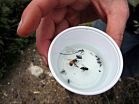(Press-News.org) SAN FRANCISCO, Dec. 19 – A global network of people monitoring bee populations may form an early warning system alerting scientists to dangers threatening the world's food system and economies.
"My goal is to give agencies all around the world an effective way to monitor bees," said San Francisco State University Professor of Biology Gretchen LeBuhn, lead author of a United Nations-sponsored study. "Biologists have talked a lot about how bee populations are declining, but I don't think we actually have good data that acts as an early warning signal for possible problems with our food system."
In an article published online Dec. 12 in the journal Conservation Biology, LeBuhn and her co-authors outlined a simple and cost-effective method for enacting a monitoring system. The study found that counting and identifying bees regularly for five years at about 200 locations would produce data accurate enough to detect two to five percent annual declines in bee populations. The program is estimated to cost $2 million and include international sampling sites, although it could be scaled to fit different regional monitoring needs.
"The estimated cost of sustaining an international monitoring program is a relatively small investment compared to the potential economic cost of severe pollinator losses," the study said. Thirty-five percent of the global food supply depends on bees and other pollinators, including crops worth nearly $200 billion each year, according to LeBuhn.
"A monitoring program should be simple, repeatable, inexpensive, and, most importantly, have the ability to quickly detect declines if they are occurring," the study said.
The proposed system relies on paid workers around the globe to count and identify bees using simple "pan traps," in which bees are attracted to a brightly-colored pan filled with liquid. To determine scalable sampling techniques, costs and time scales for completing the work, the researchers designed simulations using data from eleven previously published multi-year studies.
The research was funded by the Food and Agriculture Organization of the United Nations, and the monitoring program has already been used in Brazil, Ghana, India, Kenya, Nepal, Pakistan and South Africa, with support from the Global Environment Facility and United Nations Environment Programme. LeBuhn said the long-term goal for the project is to establish a network of monitoring stations to provide data for a global analysis.
"We hope to eventually centralize some of the data collection so that people who are counting bees regionally can contribute to a larger data set."
LeBuhn is also known for organizing the annual "Great Sunflower Project," in which 100,000 citizen scientists across North America volunteer to count bee populations in their own backyards. The project, now in its fifth year, recently found low numbers of bees in urban areas across America, adding weight to the theory that habitat loss is one of the primary reasons for sharp population declines.
INFORMATION:
SF State is the only master's-level public university serving the counties of San Francisco, San Mateo and Marin. The University enrolls nearly 30,000 students each year and offers nationally acclaimed programs in a range of fields -- from creative writing, cinema and biology to history, broadcast and electronic communication arts, theatre arts and ethnic studies. The University's more than 212,000 graduates have contributed to the economic, cultural and civic fabric of San Francisco and beyond.
Biologists design method to monitor global bee decline
Data could act as warning signal for impact on food systems
2012-12-20
ELSE PRESS RELEASES FROM THIS DATE:
Mutation hotspots in autism genes
2012-12-20
Genes implicated in autism and other human diseases are prone to frequent mutations, according to a study published by Cell Press on December 20th in the journal Cell. The study suggests that elevated mutation rates in certain parts of the genome contribute to disease risk in humans.
"Some disease-related genes are gluttons for punishment," says senior study author Jonathan Sebat of the University of California, San Diego. "Despite the fact that these genes are important for normal human development, they appear to be getting hammered with mutations."
Neurodevelopmental ...
Genomic 'hotspots' offer clues to causes of autism, other disorders
2012-12-20
An international team, led by researchers from the University of California, San Diego School of Medicine, has discovered that "random" mutations in the genome are not quite so random after all. Their study, to be published in the journal Cell on December 21, shows that the DNA sequence in some regions of the human genome is quite volatile and can mutate ten times more frequently than the rest of the genome. Genes that are linked to autism and a variety of other disorders have a particularly strong tendency to mutate.
Clusters of mutations or "hotspots" are not unique ...
Preventing prostate cancer through androgen deprivation may have harmful effects
2012-12-20
PHILADELPHIA — The use of androgen deprivation therapies to prevent precancerous prostate abnormalities developing into aggressive prostate cancer may have adverse effects in men with precancers with specific genetic alterations, according to data from a preclinical study recently published in Cancer Discovery, a journal of the American Association for Cancer Research.
"The growth and survival of prostate cancer cells are very dependent on signals that the cancer cells receive from a group of hormones, called androgens, which includes testosterone," said Thomas R. Roberts, ...
Cellular patterns of development
2012-12-20
KANSAS CITY, MO – For a tiny embryo to grow into an entire fruit fly, mouse or human, the correct genes in each cell must turn on and off in precisely the right sequence. This intricate molecular dance produces the many parts of the whole creature, from muscles and skin to nerves and blood.
So what are the underlying principles of how those genes are controlled and regulated?
At the most basic level, scientists know, genes are turned on when an enzyme called RNA polymerase binds to the DNA at the beginning of a gene. The RNA polymerase copies the DNA of the gene into ...
Gladstone scientists identify powerful infection strategy of widespread and potentially lethal virus
2012-12-20
SAN FRANCISCO, CA—December 20, 2012—Scientists at the Gladstone Institutes have mapped the molecular mechanism by which a virus known as cytomegalovirus (CMV) so successfully infects its hosts. This discovery paves the way for new research avenues aimed at fighting this and other seemingly benign viruses that can turn deadly.
Not all viruses are created equal. Some ravage the body quickly, while others—after an initial infection—lie dormant for decades. CMV is one of the eight types of human herpes viruses, a family of viruses that also include Epstein-Barr virus (which ...
Dragonflies have human-like 'selective attention'
2012-12-20
In a discovery that may prove important for cognitive science, our understanding of nature and applications for robot vision, researchers at the University of Adelaide have found evidence that the dragonfly is capable of higher-level thought processes when hunting its prey.
The discovery, to be published online today in the journal Current Biology, is the first evidence that an invertebrate animal has brain cells for selective attention, which has so far only been demonstrated in primates.
Dr Steven Wiederman and Associate Professor David O'Carroll from the University ...
Origin of life emerged from cell membrane bioenergetics
2012-12-20
A coherent pathway which starts from no more than rocks, water and carbon dioxide and leads to the emergence of the strange bio-energetic properties of living cells, has been traced for the first time in a major hypothesis paper in Cell this week.
At the origin of life the first protocells must have needed a vast amount of energy to drive their metabolism and replication, as enzymes that catalyse very specific reactions were yet to evolve. Most energy flux must have simply dissipated without use.
So where did it all that energy come from on the early Earth, and how ...
A urine test for a rare and elusive disease
2012-12-20
Boston, Mass.—A set of proteins detected in urine by researchers at Boston Children's Hospital may prove to be the first biomarkers for Kawasaki disease, an uncommon but increasingly prevalent disease which causes inflammation of blood vessels that can lead to enlarged coronary arteries and even heart attacks in some children. If validated in more patients with Kawasaki disease, the markers could make the disease easier to diagnose and give doctors an opportunity to start treatment earlier.
The discovery was reported online by a team led by members of the Proteomics Center ...
First ever 'atlas' of T cells in human body
2012-12-20
New York, NY (December 20, 2012) — By analyzing tissues harvested from organ donors, Columbia University Medical Center (CUMC) researchers have created the first ever "atlas" of
immune cells in the human body. Their results provide a unique view of the distribution and function of T lymphocytes in healthy individuals. In addition, the findings represent a major step toward development of new strategies for creating vaccines and immunotherapies. The study was published today in the online edition of the journal Immunity.
T cells, a type of white blood cell, play a major ...
Peel-and-Stick solar panels from Stanford engineering
2012-12-20
For all their promise, solar cells have frustrated scientists in one crucial regard – most are rigid. They must be deployed in stiff, often heavy, fixed panels, limiting their applications. So researchers have been trying to get photovoltaics to loosen up. The ideal: flexible, decal-like solar panels that can be peeled off like band-aids and stuck to virtually any surface, from papers to window panes.
Now the ideal is real. Stanford researchers have succeeded in developing the world's first peel-and-stick thin-film solar cells. The breakthrough is described in a ...
LAST 30 PRESS RELEASES:
NTP-enhanced lattice oxygen activation in Ce-Co catalysts for low-temperature soot combustion
Synergistic interface engineering in Cu-Zn-Ce catalysts for efficient CO2 hydrogenation to methanol
COVID-19 leaves a lasting mark on the human brain
Scientists use ultrasound to soften and treat cancer tumors without damaging healthy tissue
Community swimming program for Black youth boosts skills, sense of belonging, study finds
Specific depressive symptoms in midlife linked to increased dementia risk
An ‘illuminating’ design sheds light on cholesterol
Who is more likely to get long COVID?
Study showcases resilience and rapid growth of “living rocks”
Naval Research Lab diver earns Office of Naval Research 2025 Sailor of the Year
New Mayo-led study establishes practical definition for rapidly progressive dementia
Fossil fuel industry’s “climate false solutions” reinforce its power and aggravate environmental injustice
Researchers reveal bias in a widely used measure of algorithm performance
Alcohol causes cancer. A study from IOCB Prague confirms damage to DNA and shows how cells defend against it
Hidden viruses in wastewater treatment may shape public health risks, study finds
Unlock the power of nature: how biomass can transform climate mitigation
Biochar reshapes hidden soil microbes that capture carbon dioxide in farmland
Reducing saturated fat intake shows mortality benefit, but only in high-risk individuals
Manta rays create mobile ecosystems, study finds
Study: Mixed results in using lipoic acid to treat progressive multiple sclerosis
Norbert Holtkamp appointed director of Fermi National Accelerator Laboratory
New agentic AI platform accelerates advanced optics design
Biologists discover neurons use physical signals — not electricity — to stabilize communication
Researchers discover that a hormone can access the brain by hitchhiking
University of Oklahoma researcher awarded funding to pursue AI-powered material design
Exploring how the visual system recovers following injury
Support for parents with infants at pediatric check-ups leads to better reading and math skills in elementary school
Kids’ behavioral health is a growing share of family health costs
Day & night: Cancer disrupts the brain’s natural rhythm
COVID-19 vaccination significantly reduces risk to pregnant women and baby
[Press-News.org] Biologists design method to monitor global bee declineData could act as warning signal for impact on food systems





